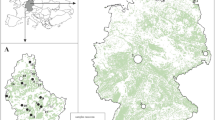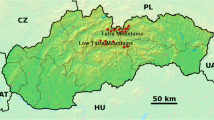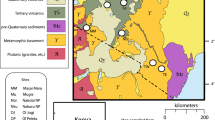Abstract
Museum and recent collections of raccoon hair were used to assess whether temporal or spatial trends existed in MMHg distributions in south Florida. The hypothesis that MMHg in raccoon hair had remained the same since 1947 could not be rejected. Some sampling regions showed increases while others did not. However, large differences existed between sites, amounting to a factor of 20 for raccoons collected during 2000 and during the period prior to 1960 (museum samples). Raccoon feeding behavior and the production of MMHg most probably accounted for the spatial differences. Large differences in MMHg concentrations existed in different tissues ranging in order of hair, liver, kidney, muscle, heart, brain, and blood in their respective ratios to blood: 96:10:6:5:4:2.5:1. Liver Hg is 7% MMHg, while hair Hg is 99% MMHg. These associations appear largely regulated by metabolic processes. Speciation of Hg is very important for gaining an understanding of ecosystem and organism Hg dynamics. Further work is needed to establish whether Se plays a role in Hg sequestration and whether hair Hg is a good surrogate for estimating Hg concentrations in other tissues in south Florida raccoon populations.
Similar content being viewed by others
References
Arnold, B.S. (2000). Distribution of mercury within different trophic levels of the Okefenokee swamp, within tissues of top level predators, and reproductive effects of methyl mercury in the Nile tilapia (Oreochromis niloticus). PhD Dissertation. University of Georgia, Athens GA. 200 pp.
Atkeson, T. and Parks, P. (2001) (draft). Chapter 2B: mercury monitoring, research, and environmental assessment. In SFWMD. 2002. Everglades Consolidated Report. South Florida Water Management District. West Palm Beach, FL, pp. 2B–1–27.
Berg, W., Johnels, A., Sjöstrand, B. and Westermark. T. (1966). Mercury content in feathers of Swedish birds from the past 100 years. Oikos 17, 71–83.
Bloom, N.S. (1992). On the chemical form of mercury in edible fish and marine invertebrate tissue. Can.J.Fish.Aquat.Sci. 49, 1010–7.
Caldwell, J.A. (1963). An Investigation of Raccoons in North-central Florida. Master of Science Thesis, University of Florida, Gainesville, FL. 88 pp.
Cernichiaria, E., Brewer, R., Myers, G.J., Marsh, D.O., Lapham, L.M., Cox, C., Shamlaye, C.F., Berlin, M., Davidson, P.W. and Clarkson, T.W. (1995a). Monitoring methylmercury during pregnancy: maternal hair predicts fetal brain exposure. NeuroToxicology 16, 705–10.
Cernichiaria, E., Toribara, T.Y., Liang, L., Marsh, D.O., Berlin, M.W., Myers, G.J., Cox, C., Shamlaye, C.F., Choisy, O., Davidson, P.W. and Clarkson, T.W. (1995b). The biological monitoring of mercury in the Seychelles study. NeuroToxicology 16, 613–28.
Chupp, C. and Sherf, A.F. (1960). Vegetable Diseases and Their Control. New York: The Roland Press Company.
Clarkson, T.W. (1994). The toxicology of mercury and its compounds. In C.J. Watras and J.W. Huckabee (eds) Mercury Pollution: integration and synthesis, pp. 631–41. Boca Raton: Lewis Publishers. FL: CRC Press.
Cleckner, L.B., Garrison, P.J., Hurley, J.P., Olson, M.L. and Krabbenhoft, D.P. (1998). Trophic transfer of methyl mercury in the northern Florida Everglades. Biogeochemistry 40, 347–61.
Cornwell, G.W. and Atkins, K. (1975). The Impact of Evicting Farmers from Everglades National Park's Hole-in-the-Donut. Report to the South Florida Tomato and Vegetable Growers, Inc. Homestead, FL. 184 pp.
Cumbie, P.M. (1975a). Mercury in hair of bobcats and raccoons. J.Wildl.Manage. 39, 419–25.
Cumbie, P.M. (1975b). Mercury accumulation in wildlife in the southeast. PhD Dissertation. University of Georgia, Athens, GA. 148 pp.
Cumbie, P.M. and Jenkins, J. H. (1974). Mercury accumulation in native mammals of the southeast. In Proceedings of the 28th Annual Conference of the Southeastern Association of Game and Fish Commissioners, pp. 639–48. (NB: lower coastal plain of GA, mean raccoon hair is 6.1 ppm Hg, range is 0.23–50.6.)
Davis, A.H. (1981). Ecological and physiological parameters of mercury and cesium-137 accumulation in the raccoon. PhD Dissertation. University of Georgia, Athens, GA. 154 pp. (NB: coastal Georgia raccoon hair mean is 6.7 ppm Hg, range is 0.3–27.51.)
Delfino, J.J., Crisman, T.L., Gottgens, J.F., Rood, B.E. and Earle, C.D.A. (1993). Spatial and temporal distribution of Hg in Everglades and Okefenokee wetland sediments. University of Florida. Gainesville, FL. 140 pp.
Eisemann, J.D., Beyer, W.N., Bennetts, R.E. and Morton, A. (1997). Mercury residues in south Florida apple snails (Pomacea paludosa). Bull.Environ.Contam.Toxicol. 58, 739–43.
EPRI. (1996). Protocol for estimating historic atmospheric mercury deposition. EPRI TR-106768. Electric Power Research Institute. Palo Alto, CA. 49 pp.
Evans, R.D., Addison, E.M., Villeneuve, J.Y., MacDonald, K.S., and Joachim, D.G. (2000). Distribution of Inorganic and methylmercury among tissues in mink (Mustela vison) and otter (Lutra canadensis). In Proceedings of Mercury as a Global Pollutant: 5th International Conference, Rio de Janeiro, Brazil, 23–28 May 1999. New York, NY: Academic Press.
Ewel, J.J., Ojima, D.S., Karl, D.A. and DeBusk, W.F. (1982). Schinus in successional ecosystems of Everglades National Park, Report T-676. National Park Service, South Florida Research Center, Everglades National Park, Homestead, FL. 141 pp.
Fortin, C., Beauchamp, G., Dansereau, M., Lariviere, N. and Belanger, D. (2001). Spatial variation in mercury concentrations in wild mink and river otter carcasses from the James Bay Territory, Quebec, Canada. Arch.Environ.Contam.Toxicol. 40, 121–7.
Frederick, P.C., Spalding, M.G. and Dusek, R. (2002). Wading birds as bioindicators of mercury contamination in Florida, USA: annual and geographic variation. Environ.Toxicol.Chem. 21, 163–7.
Gilmour, C.C., Riedel, G.S., Ederington, M.C., Bell, J.T., Benoit, J.M., Gill, G.A. and Stordal, M.C. (1998). Methyl-mercury concentrations and production rates across a trophic gradient in the northern Everglades. Biogeochemistry 40(2/3), 327–45.
Gough, L.P., Kotra, R.K., Holmes, C.W., Orem, W.H., Hageman, P.L., Biggs, P.H., Meier, A.L. and Brown, Z.A. (2000). Regional geochemistry of metals in organic-rich sediments, sawgrass and surface water, from Taylor Slough, Florida. USGS Open-file Report 00–327. US Dept. Interior, US Geological Survey. Reston, VA. 62 pp.
Grieb, T.M., Driscoll, C.T., Gloss, S.P., Schofield, C.L., Bowie, G.L. and Porcella, D.B. (1990). Factors affecting mercury accumulation in fish in the Upper Michigan Peninsula. Environ.Toxicol.Chem. 9, 919–30.
Guentzal, J.L., Landing, W.M., Gill, G.A. and Pollman, C.D. 1998. Mercury and major ions in rainfall, throughfall, and foliage from the Florida Everglades. Sci.Total Environ. 213, 43–51.
Guentzal, J.L., Landing, W.M., Gill, G.A. and Pollman, C.D. (2001). Processes influencing rainfall deposition of mercury in Florida. Environ.Sci.Technol. 35, 863–73.
Harris, R.C. and Bodaly, R.A. (1998). Temperature, growth and dietary effects on fish mercury dynamics in Two Ontario Lakes. Biogeochemistry 40, 175–87.
Hudson, R.J.M., Gherini, S.A., Watras, C.J. and Porcella, D.B. (1994). A mechanistic model of the biogeochemical cycle of mercury in lakes. In C.J. Watras and J.W. Huckabee (eds) Mercury Pollution: Integration and Synthesis, Boca Raton: Lewis Publishers pp. 473–523.
Jernelov, A., Johansson, A., Sorensen, L. and Svenson, A. (1976). Methylmercury degradation in mink. Toxicology 6, 315–21.
Johnson, A.S. (1970). Biology of the raccoon in Alabama. Agricultural Experiment Station. Auburn University. Auburn AL. 148 pp.
Lange, T.H., Royals, H. and Connor, L.L. (1993). Influence of water chemistry on mercury concentration in largemouth bass from Florida lakes. Trans.Am.Fish.Soc. 122, 74–84.
Liang, L. (1998). Determination of arsenic in ambient water at sub-part-per-trillion level by hydride generation Pd coated platform collection and GFAAS detection. Talanta 47, 569–583.
Lindberg, P. and Odsjö, T. (1983). Mercury levels in feathers of peregrine falcon Falco peregrinus compared with total mercury content in some of its prey species in Sweden. Environ.Poll. (Series B) 5, 297–318.
Loftus, W.F., Trexler, J.C. and Jones, R.D. (1998). Mercury transfer through an Everglades aquatic food web. Final Report to the Florida Department of Environmental Protection, December 1998, contract SP-329. Department of Biol. Sci. and SE Environ. Res. Prog., Florida International University, Miami, FL.
Loope, L.L. and Dunevitz, V.L. (1981). Impact of fire exclusion and invasion Schinus terebinthifolius on limestone rockland pine forests of southeastern Florida. National Park Service. South Florida Research Center. Everglades National Park. Rept T-645. 30 pp.
Monteiro, L.R. and Furness, R.W. (1997). Accelerated increase in mercury contamination in North Atlantic mesopelagic food chains as indicated by time series of seabird feathers. Environ.Toxicol.Chem. 16, 2489–93.
Newman, J.R., Zillioux, E.J., Rich, E.R., Robertson, W.B. Jr., Atkeson, T.D. and Whitten, M.L. (1994). Historical contamination mercury in the Florida panther (Felix concolor coryi) and its prey: preliminary results. Poster at the Third Int.Conf.on Mercury as a Global Poll. Whistler, B.C., Canada. 4 pp.
Newton, I., Wyllie, I. and Asher, A. (1993). Long-term trends in organochlorine and mercury residues in some predatory birds in Britain. Environ.Pollut. 79, 143–51.
Roelke, M.E., Schultz, D.P., Facemire, C.F., Sundlof, S.F. and Royals, H.E. (1991). Mercury contamination in Florida panthers. Report to the Florida Panther Interagency Committee. FL Game and Fresh Water Fish Commission, Fish. Res. Lab. PO Box 1903, Eustis FL 33727, 54 pp.
Rood, B.E., Gottgens, J.F., Delfino, J.J., Earle, C.D. and Crisman, T.L. (1995). Mercury accumulation trends in Florida Everglades and Savannas Marsh flooded soils. Water Air Soil Pollut. 80, 981–90.
SAS Institute (1998). StatView. Version 5.
Sheffy, T.B. and St. Amant, J.R. (1982). Mercury burdens in furbearers in Wisconsin. J.Wildlife Management 46, 1117–20.
Stober, Q.J., Jones, R.D. and Scheidt D.W. (1995). Ultra trace level mercury in the Everglades ecosystem, a multimedia canal pilot study. Water, Air, Soil Pollut. 80, 991–1001.
Stober, J., Scheidt, D., Jones, R., Thornton, K., Ambrose R., and France, D. (1996). South Florida Ecosystem Assessment. Monitoring for Adaptive Management: Implications for Ecosystem Restoration (Interim Report). EPA-904-R–96–008. Region 4. USEPA, Athens, GA. 32pp.
USEPA (1993). Wildlife Exposure Factors Handbook. EPA/600/R-93/187. USEPA, 401 M St., Washington. DC. 20460.
USEPA (1997). Mercury Study Report to Congress. EPA 452/R–97–003. USEPA, 401 M St., Washington. DC. 20460.
USEPA (1998). Method 1630 (draft): methyl mercury in water by distillation, aqueous ethylation, purge and trap, and cold vapor atomic fluorescence spectrometry. USEPA, 401 M St., Washington. DC. 20460. 33 pp.
USEPA (1999). Method 1631, Revision B: mercury in water by oxidation, purge and trap, and cold vapor atomic fluorescence spectrometry. EPA-821-R–99–005. USEPA, 401 M St., Washington. DC. 20460. 33pp.
Wagemann, R., Trebacz, E., Boila, G. and Lockhart, W.L. (2000). Mercury species in the liver of ringed seals. Science Total Env. 261, 21–32.
Wren, C.D. (1986). A review of metal accumulation and toxicity in wild mammals. Environ.Research. 40, 210–44.
Wren, C., MacCrimmon, H., Frank, R. and Suda, P. (1980). Total and methyl mercury levels in wild mammals from the precambrian shield area of south central Ontario, Canada. Bull.Environ.Contam.Toxicol. 25, 100–5.
Author information
Authors and Affiliations
Rights and permissions
About this article
Cite this article
Porcella, D.B., Zillioux, E.J., Grieb, T.M. et al. Retrospective Study of Mercury in Raccoons (Procyon lotor) in South Florida. Ecotoxicology 13, 207–221 (2004). https://doi.org/10.1023/B:ECTX.0000023566.05061.3c
Issue Date:
DOI: https://doi.org/10.1023/B:ECTX.0000023566.05061.3c




